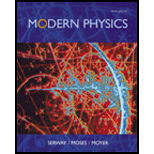
Concept explainers
(a)
(a)
Answer to Problem 6P
Wavelength is
Explanation of Solution
Write the Hubble’s law equation.
Here,
Write the relativistic doppler formula.
Here,
Conclusion:
Substitute
Substitute 590 nm for
Thus, the wavelength is
(b)
Wavelength of light emitted from a galaxy lies at
(b)
Answer to Problem 6P
Wavelength is
Explanation of Solution
Substitute
Substitute 590 nm for
Conclusion:
Thus, the wavelength is
(b)
Wavelength of light emitted from a galaxy lies at
(b)
Answer to Problem 6P
Wavelength is
Explanation of Solution
Substitute
Substitute 590 nm for
Conclusion:
Thus, the wavelength is
Want to see more full solutions like this?
- Suppose the Hubble constant were not 22 but 33 km/s per million light-years. Then what would the critical density be?arrow_forwardIs the Hubble constant actually constant?arrow_forwardIf a galaxy moving away from the Earth has a speed of 1000 km/s and emits 656 nm light characteristic of hydrogen (the most common element in the universe). Why is the speed of the Earth in its orbit negligible here?arrow_forward
- If a galaxy is 9.2 Mpc away from Earth and recedes at 475 km/s, what is H0 (in km/s/Mpc)?arrow_forwardIn the laboratory, one of the lines of sodium is emitted at a wavelength of 590.0 nm. In the light from a particular galaxy, however, this line is seen at a wavelength of 602.0 nm. Calculate the distance to the galaxy, assuming that Hubble’s law holds and that the Doppler shift of Eq. 37-36 applies.arrow_forwardImagine that an observed distant galaxy is measured to have a distance of 40 Mpc by a Type Ia supernovae and the redshift of the galaxy indicates the galaxy appears to be moving away from us at a speed of 2400 km/s. What would the Hubble constant be if measured solely based on this galaxy in units of km/s/Mpc?arrow_forward
- An electron jumps from n=3 to n=2 in a hydrogen atom in a distant galaxy, emitting light. If we detect that light at a wavelength of 3.00 mm, by what multiplication factor has the wavelength, and thus the universe, expanded since the light was emitted?arrow_forwardExplain how the Hubble constant, H0, can be used to make an estimate for the age of the Universe. Use the value of H0 = 0.07×103 kms-1/Mpc to estimate the Universe’s age. Comment on the significance of your answer.arrow_forwardThere is still some uncertainty in the Hubble constant. Current estimates range from about 19.9 km/s per million light years to 23 km/s per million light-years. Assume that the Hubble constant has been constant since the Big Bang.arrow_forward
 Modern PhysicsPhysicsISBN:9781111794378Author:Raymond A. Serway, Clement J. Moses, Curt A. MoyerPublisher:Cengage Learning
Modern PhysicsPhysicsISBN:9781111794378Author:Raymond A. Serway, Clement J. Moses, Curt A. MoyerPublisher:Cengage Learning Principles of Physics: A Calculus-Based TextPhysicsISBN:9781133104261Author:Raymond A. Serway, John W. JewettPublisher:Cengage Learning
Principles of Physics: A Calculus-Based TextPhysicsISBN:9781133104261Author:Raymond A. Serway, John W. JewettPublisher:Cengage Learning Foundations of Astronomy (MindTap Course List)PhysicsISBN:9781337399920Author:Michael A. Seeds, Dana BackmanPublisher:Cengage Learning
Foundations of Astronomy (MindTap Course List)PhysicsISBN:9781337399920Author:Michael A. Seeds, Dana BackmanPublisher:Cengage Learning AstronomyPhysicsISBN:9781938168284Author:Andrew Fraknoi; David Morrison; Sidney C. WolffPublisher:OpenStax
AstronomyPhysicsISBN:9781938168284Author:Andrew Fraknoi; David Morrison; Sidney C. WolffPublisher:OpenStax Stars and Galaxies (MindTap Course List)PhysicsISBN:9781337399944Author:Michael A. SeedsPublisher:Cengage Learning
Stars and Galaxies (MindTap Course List)PhysicsISBN:9781337399944Author:Michael A. SeedsPublisher:Cengage Learning




